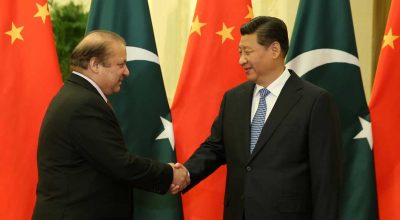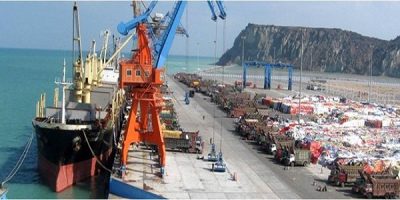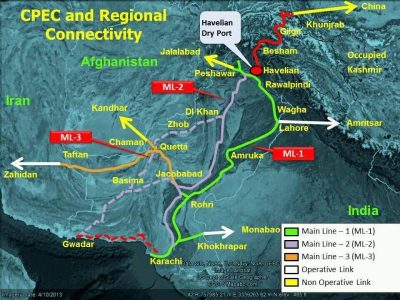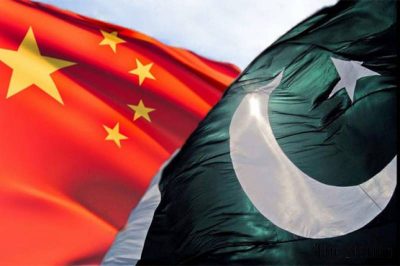By
Sabena Siddiqi
The China Pakistan Economic Corridor runs through one of the most important and central geo-strategic locations in South Asia.
Gwadar is the largest and deepest sea port in this part of the world, also its natural layout and depth enables the largest tonnage ships to dock there, a characteristic which is absent in Dubai and Chahbahar ports.
Projects encompassing the CPEC were worth $46 billion initially, this being the largest investment by China in a foreign country. The amount is equal to a fifth of Pakistan’s GDP and more than twice the total amount of direct foreign investment here since 2008.
The plan is to use 35 to 38 billion US dollars on energy projects and the rest on development of infrastructure, according to a report placed on the website of China’s State Council Information Office.
It specifies $11.6 billion allocated for the Khyber Pakhtunkhwa province, $11.5 billion in Sindh, $7.1 billion in Balochistan and $6.9 billion in Punjab.
Gilgit Baltistan is the gateway of CPEC, projects to address energy issues are already in progress there.
Lesser developed areas of Punjab, Khyber-Pakhtunkhwa and Balochistan are linked with the CPEC road network while Gwadar port will help decrease the congestion faced by Karachi Port which usually faces a glut of commercial, civil and military shipping. This would also end the possibility of any naval blockade of Karachi port by India.
Gwadar port
There were some misunderstandings among provinces regarding the route of the corridor, but those issues were sorted out.
Any future issues between provinces regarding benefits and resources would be resolved by the Council of Common Interest, so that aspect is under control now.
The current elected PMLN government is elated with the prospect of taking the credit for CPEC in the coming elections in 2018.
The downside is that the general Pakistani public has little access to details of the project, more specifics regarding the CPEC needing to be shared. Chinese firms are mostly involved in the execution and funding is arranged from EXIM bank and the Silk Road Fund.
The latest World Bank report evaluated Pakistan’s economy with positive growth following the CPEC investment.
It is also feared by local businessmen and industrialists that Chinese products and goods will flood Pakistani markets due to heightened accessibility. Pakistan just needs to keep good quality standards and improve its efficiency to continue its trade unhindered.
The CPEC would generate thousands of jobs and revenue worth billions of dollars for both countries. Mainly it would provide Pakistan with massive essential infrastructure, energy investment and development.
These are the most immediate advantages the project provides for Pakistan.
It is vital that both China and Pakistan make sure that Balochi companies and workers play a prominent role and feel involved in the development project; locals should not feel that the demographics of the province will be affected.
A special security force comprising 10,000 personnel will soon become completely operational from Gwadar to Karakoram Highway, to make sure that no unruly elements try to disrupt the project.
Considering the larger picture, Gwadar is perceived as part of China’s ‘String of Pearls‘ naval strategy and is its most important strategic gambit.
China’s US$5 trillion worth sea-borne trade plies via the South China Sea where the Straits of Malacca become a choke point, Gwadar provides it the alternative trade route for the Gulf regions via the Arabian Sea. Shorter and cost-efficient, it provides China an inter-connected infrastructure network to link its economy with the rest of the world. Chinese goods would now come down a 3000 km route to reach the warm waters of Gwadar.
CPEC is said to provide China the clout it needed to counter the U.S. agenda of ‘Pivot to Asia’. Traditional key players for containing the Dragon on behalf of the U.S are Japan, Indonesia, Singapore and India.
In this strategic scenario, Pakistan emerges as a major player that can balance superpower rivalries and promote trade co-operation.
China-Pakistan relations have a particular synergy lacking in most strategic partnerships in the region. Beijing supports Pakistan’s military ambitions and perpetually blocks Indian efforts to be member of UN Security Council, NSG etc.
Our neighbour India has been keenly watching the progress of CPEC, looking for opportunities to subvert it as it fears encirclement by China and Pakistan. It views CPEC as a mega-scale naval mobilization program that threatens its security and puts global sea lanes at risk.
India worries as China invests in a new batch of nuclear reactors for Pakistan, giving it a total power capacity of 7,930 MW by 2030, it feels like China is moving next door to safeguard its $46 billion investment.
If viewed from the Indian perspective, CPEC looks like an ominous pact between two of its biggest enemies. It tried to counter the threat by investing in the Iranian port of Chahbahar, which lacks the location, facilities and capacity offered by Gwadar.
Chahbahar’s maximum planned capacity is only 10 to 12 million tons a year, it also cannot provide a safe passage for trade through Afghanistan as it remains in turmoil.
In 2016, Gwadar had a total traffic of half a million tons cargo which is expected to double in 2017. At completion it will handle 300 to 400 tons per annum and will be a city of 2 million residents according to planners.
All of India’s 212 ports handle 500 million tons a year while Long Beach, America’s largest port, handles 80 million tons a year, which is just 20% of the Gwadar port capacity.
Notwithstanding the advantages of CPEC for the entire region, India wants to deny Pakistan the advantage of its geo-strategic location. Recently an Indian naval officer Kulbhushan Yadav was caught running terrorist cells within Pakistan.
Impervious to Indian objectives, Iran could have $100 billion worth of energy deals with China in the near future, there also being a proposal to link the Iran-Pakistan gas pipeline with China.
The importance of CPEC to China makes any Indian sub-conventional response very risky. India may not be able to handle the backlash from China, also the more China increases its investment in Pakistan, the more impossible it will become to dissuade it from discontinuing the CPEC.
The general perception is that Pakistan’s relations with the U.S. will deteriorate due to the CPEC. U.S. investors have pulled out $71.9 million in the last 11 months whereas U.S. investment amounted to $197.1 million in the previous year, this just one of the indicators of its displeasure; nowadays Pak-U.S. relations lack enthusiasm.
China increased its investment even more to cover the loss as other investors pulled out. EXIM bank is to pitch in $20 million for the Nawabshah – Sanghar road, offsetting the decrease in investments from the rest of the world.
The CPEC has global trade implications, Pakistan must secure it’s strategic and economic interests and learn how to balance the two major powers, U.S. and China, without upsetting the apple cart.
In the last 13 years, the U.S. gave Pakistan about $10.5 billion in economic assistance, $7.6 billion in security-related aid, and $13 billion in counterterrorism support. Even recently the U.S. Senate passed $1.1 billion under the Security Enhancement Act on account of mutual strategic partnership, but somehow it never took an interest in building dams, power plants, roads, bridges or ports.
China views its relationship with allies on a geo-strategic, and geo-economics basis, the purpose of the CPEC being to spur foreign investment and accelerate trade.
The United States could plan on a similar pattern and help put Pakistan on the road to financial security and political stability, directing some civilian assistance into CPEC-aligned projects such as improving Pakistan’s national power grid.
The U.S. will most definitely continue to play a constructive role in Pakistan as it has since the last 70 years, it being an opportunity for tri-lateral co-operation, already having heavy economic and trade ties with China.
Today, even after striking a nuclear deal with Iran, the U.S. may not completely trust Iran or its new ally India, and cannot afford to lose its influence in Pakistan.
India’s all-time strategic partner is Russia and not the U.S., Modi calling Russia ‘a pillar of strength’ and India’s ‘most important defence partner’. This angle will upset the India-U.S. equation in the long-term as Washington cannot tolerate Moscow.
The U.S. Senate recently rejected an amendment designating India as a “major defense partner” even though India had high hopes after Modi’s address to U.S. Congress.
The Chinese government has expressed the hope that work on the CPEC projects will be completed before scheduled time, it being a top priority in the next Chinese five year plan, according to the SCIO report. Pakistan’s profile has improved as an economic destination and economic indicators have risen.
The CPEC project has moved ahead according to schedule and Pakistan seems poised to take it onwards to completion smoothly, unless India attempts some major misadventure or attack.






Thanks for this very interesting piece. It helps to clarify a few misconceptions regarding the budget allocation. As i heard that Punjab was getting more out of it, but clearly every province has been given due attention and much needed development. Long Live Pakistan And Long Live China
Excellent and very informative article. Thank you